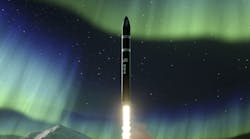Lockheed Martin is reported to be the U.S. Missile Defense Agency’s choice to supply a new system to intercept intercontinental ballistic missiles. The multi-year contract could be worth an estimated $17.7 billion according to available government estimates, with initial availability for the Next Generation Interceptor now seen in 2028.
Last August, Lockheed reported it successfully validated designs for all elements of its Next Generation Interceptor (NGI) project with the U.S. Missile Defense Agency, keeping that new defense system on track for deployment later this decade.
While it’s still in the developmental stage, Lockheed has described its NGI technology as a “never fail weapon system” that will enhance protection for military and civilian assets. Lockheed’s system is designed to identify missile launches, locate targets, calculate routes, and guide the interceptor during its transit to the target.
The MDA is also known to be evaluating an interceptor system under development by Northrop Grumman Corp.
The agency set up the NGI project in 2019 after a previous, space-based technology concept was abandoned. The goal is to update the current Ground-Based Midcourse Defense program, which is based on network of radar-based detectors and anti-ballistic missiles to shield the United States from ICMBs, and to establish the capability to defeat current and future ballistic missile capabilities, and to anticipate future weapons technologies that may be developed for long-range threats.






